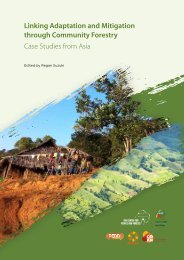Desktop Study on - Regional Climate Change Adaptation ...
Desktop Study on - Regional Climate Change Adaptation ...
Desktop Study on - Regional Climate Change Adaptation ...
Create successful ePaper yourself
Turn your PDF publications into a flip-book with our unique Google optimized e-Paper software.
Assessment of Capacity Gaps and Needs of South East Asia Countries<br />
in Addressing Impacts, Vulnerability and Adaptati<strong>on</strong> to <strong>Climate</strong> Variability and <strong>Climate</strong> <strong>Change</strong><br />
From those, Terengganu, Kelantan, Perlis, Kedah<br />
and Perak are the most vulnerable states in terms<br />
of hardcore poverty and projected temperature and<br />
rainfall changes. Also the most vulnerable peoples<br />
due to climate change are the poor and hardcore<br />
poor who have relatively larger household members<br />
(Siwar et al, 2009).<br />
The Initial Communicati<strong>on</strong> gives a serie of adaptati<strong>on</strong><br />
measures that are based <strong>on</strong> defence (building bunds/<br />
seawalls/levees/dykes/etc.), accommodati<strong>on</strong>, to<br />
retreat, which includes the relocati<strong>on</strong> of affected<br />
people <strong>on</strong> a proactive way to avoid adverse impacts.<br />
An innovative measure is to transfer the line of<br />
defence seaward and reclaim the intervening area.<br />
This measure has the added advantage of being able<br />
to incorporate the projected sea level rise into its<br />
planning and design and has become popular in large<br />
segments of the west coast of Peninsular Malaysia.<br />
The Coastal Land Buyback is a proactive approach<br />
to c<strong>on</strong>vert private ownership to public domain and<br />
left the land as a nature reserve/corridor within<br />
which the natural variati<strong>on</strong> of shoreline movement<br />
is permitted to take place. Finally, Malaysia is now<br />
in the process of embarking <strong>on</strong> an ICZM (Integrated<br />
Coastal Z<strong>on</strong>e Management) initiative in which the<br />
potential impacts of sea level rise are given special<br />
c<strong>on</strong>siderati<strong>on</strong> in planning, and where previous<br />
measures can be c<strong>on</strong>sidered as comp<strong>on</strong>ents (MOSTE,<br />
2000).<br />
Gaps Identified in Programmes and<br />
Studies<br />
The adaptati<strong>on</strong> measures are feasible in the<br />
Malaysian c<strong>on</strong>text, but additi<strong>on</strong>al efforts are needed<br />
to quantify them in terms of cost implicati<strong>on</strong>s. Some<br />
of these additi<strong>on</strong>al efforts include further research<br />
and development in improving the science of<br />
predicti<strong>on</strong> of the resp<strong>on</strong>ses and quantitative bases<br />
for estimating impacts and ec<strong>on</strong>omic costs (MOSTE,<br />
2000).<br />
There is a need to refine the methodology of costing<br />
socio-ec<strong>on</strong>omic impacts through more research as<br />
well as to establish a disaster impact inventory. In<br />
additi<strong>on</strong>, it is necessary to develop and incorporate<br />
ec<strong>on</strong>omic recovery plans in dealing with disasters.<br />
There is also a need to study n<strong>on</strong>-communicable<br />
diseases that may result from changes in the<br />
climate scenario such as increased stress within<br />
residents of small houses or flats as a result of rising<br />
temperatures. The management of energy, water<br />
and land resources need to be planned to balance<br />
demand and supply with adequate emphasis <strong>on</strong> the<br />
management of c<strong>on</strong>sumpti<strong>on</strong>. More acti<strong>on</strong> should be<br />
taken towards providing more informati<strong>on</strong> to policy<br />
makers to promote informati<strong>on</strong>-based decisi<strong>on</strong>making<br />
(MOSTI, 2007).<br />
CROSS-SECTORAL<br />
INSTITUTIONAL SETTINGS<br />
Two different domains could be identified as<br />
being cross-sectoral instituti<strong>on</strong>al arrangements,<br />
i.e. climate change instituti<strong>on</strong>s, <strong>on</strong> the <strong>on</strong>e hand,<br />
and instituti<strong>on</strong>al settings c<strong>on</strong>cerning disaster risk<br />
reducti<strong>on</strong>, <strong>on</strong> the other hand.<br />
<strong>Climate</strong> <strong>Change</strong><br />
Since the Third Malaysia Plan (1976-1980) the<br />
envir<strong>on</strong>mental c<strong>on</strong>cerns are progressively being<br />
emphasized in development plans (Hezri and Hasan,<br />
2006). Many ministries formulated policies that<br />
have taken into account envir<strong>on</strong>mental c<strong>on</strong>cerns <strong>on</strong><br />
sectoral specific c<strong>on</strong>text; all these climate related<br />
policies in Malaysia include the Nati<strong>on</strong>al Policy <strong>on</strong> the<br />
Envir<strong>on</strong>ment, Nati<strong>on</strong>al Forest Policy, Biodiversity<br />
Policy, Nati<strong>on</strong>al Energy Policy, Nati<strong>on</strong>al Transport<br />
Policy (Land) and Third Nati<strong>on</strong>al Agricultural Policy,<br />
am<strong>on</strong>g others. Although sectoral in nature, these<br />
policies also c<strong>on</strong>tribute indirectly to addressing<br />
climate change (Muthusamy, 2007), however, there<br />
is no clear indicati<strong>on</strong> of climate change in any of<br />
them. Furthermore, there is need for the various<br />
policies to be harm<strong>on</strong>ized with each other so that<br />
win-win opti<strong>on</strong>s could be formulated through interagency<br />
collaborati<strong>on</strong> and coordinati<strong>on</strong> for climate<br />
change mitigati<strong>on</strong> and adaptati<strong>on</strong> measures. The<br />
reviews of the Ninth Malaysia Plan (2006-2010), the<br />
currently <strong>on</strong>going development plans, and several<br />
nati<strong>on</strong>al policies reveal some programs that directly<br />
or indirectly c<strong>on</strong>tribute to managing issues of climate<br />
change adaptati<strong>on</strong> and mitigati<strong>on</strong> (Pereira and Tan,<br />
2008).<br />
<strong>Climate</strong> change is cross-sectoral issue, involving<br />
more than envir<strong>on</strong>mental c<strong>on</strong>cerns, but also affecting<br />
ec<strong>on</strong>omic growth and human well-being. As it has<br />
been said, while the past and existing nati<strong>on</strong>al policies<br />
have indirectly addressed climate change c<strong>on</strong>cerns<br />
under the c<strong>on</strong>text of sustainable development, the<br />
need to formulate a specific climate change policy is<br />
increasingly recognized. In view of this, the Ministry<br />
of Natural Resources and Envir<strong>on</strong>ment of Malaysia in<br />
collaborati<strong>on</strong> with the Institute for Envir<strong>on</strong>ment and<br />
Development (LESTARI), University Kebangsaan<br />
Malaysia, had c<strong>on</strong>ducted the Policy <str<strong>on</strong>g>Study</str<strong>on</strong>g> <strong>on</strong> <strong>Climate</strong><br />
<strong>Change</strong>. The aim of the study was to develop a<br />
149

















